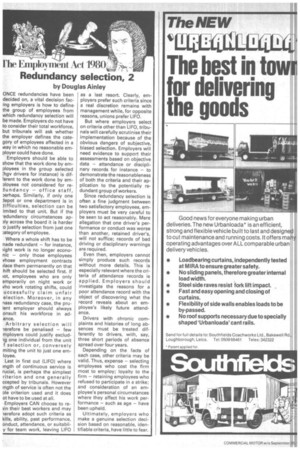Redundancy selection, 2
Page 42

If you've noticed an error in this article please click here to report it so we can fix it.
by Douglas Ainley
ONCE redundancies have been decided on, a vital decision facing employers is how to define the group of employees from which redundancy selection will be made. Employers do not have to consider their total workforce, but tribunals will ask whether the employer defines the category of employees affected in a way in which no reasonable employer could have done.
Employers should be able to show that the work done by employees in the group selected :hgv drivers for instance) is dif'erent to the work done by employees not considered for relundancy — office staff, perhaps. Similarly, if only one Jepot or one department is in Jifficulties, selection can be imited to that unit. But if the 'edundancy circumstances apply across the board it is harder o justify selection from just one ategory of employee.
Where a whole shift has to be nade redundant — for instance, light work is no longer econonic — only those employees vhose employment contracts )lace them permanently on that hift should be selected first. If lot, employees who are only emporarily on night work or vho work rotating shifts, could uccessfully claim unfair election. Moreover, in any lass redundancy case, the prulent employer should always onsult his workforce in adance.
Arbitrary selection will ierefore be penalised — few mployers could justify exclud-ig one individual from the unit I selection or, conversely miting the unit to just one emloyee.
Last in first out (LIFO) where ?ngth of continuous service is rucial, is perhaps the simplest riterion and one generally ccepted by tribunals. However mgth of service is often not the Pie criterion used and it does ot have to be used at all.
Employers CAN choose to re)in their best workers and may ierefore adopt such criteria as kills, ability, past performance, onduct, attendance, or suitabily for team work, leaving LIFO as a last resort. Clearly, employers prefer such criteria since a real discretion remains with management while, for opposite reasons, unions prefer LIFO.
But where employers select on criteria other than LIFO, tribunals will carefully scrutinise their implementation because of the obvious dangers of subjective, biased selection. Employers will need evidence to support their assessments based on objective data — attendance or disciplinary records for instance — to demonstrate the reasonableness of both the criteria and their application to the potentially redundant group of workers.
Since redundancy selection is often a fine judgment between two satisfactory employees, employers must be very careful to be seen to act reasonably. Mere allegation that one driver's performance or conduct was worse than another, retained driver's, will not suffice; records of bad driving or disciplinary warnings are required.
Even then, employers cannot simply produce such records without more details. This is especially relevant where the criteria of attendance records is applied. Employers should investigate the reasons for a poor attendance record with the object of discovering what the record reveals about an employee's likely future attendance.
Drivers with chronic complaints and histories of long absences must be treated differently to drivers, with, say, three short periods of absence spread over four years.
Depending on the facts of each case, other criteria may be valid. Thus, expense — selecting employees who cost the firm most to employ; loyalty to the firm — retaining employees who refused to participate in a strike; and consideration of an employee's personal circumstances where they affect his work performance — such as age — have been upheld.
Ultimately, employers who make a genuine selection decision based on reasonable, identifiable criteria, have little to fear.












































